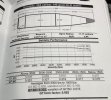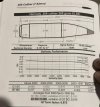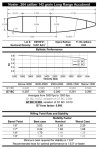entoptics
Well-Known Member
- Joined
- Jan 16, 2018
- Messages
- 878
I frequently use LabRadar data (shot tracking files from the SD card) to calculate ballistic coefficients using the JBM Ballistics web tool. Some of the results I got recently for a new rifle prompted me to post this as an FYI.
Here's a table of the 23 different bullets I've tested in the last couple of years, which have sufficient quality data to report, sorted from best to worst in terms of measured vs advertised...
This data is all from tracking at least 100 yards, and uses atmospheric data from a Kestrel 3500 and my iPhone/Watch barometer. All bullets were fired from barrels with twist rates that were at or faster than recommended.
17 of 23 bullets were within 5% of quoted (18 if you count the 62 HPBT that was 6% better than quoted).
7 of 23 were better than quoted.
3 of 7 manufacturers had bullets that were consistently lower than quoted
2 of 7 manufacturers had no bullets within 7% of quoted
1 of 7 manufacturers had no bullets within 10% of quoted.
I may be a bit cynical, but I can't get past the feeling that some manufacturers are either incompetent or intentionally misleading when they provide a B.C. value that is so far off of reality. If I can get values within spitting distance of Berger/Hornady/Sierra/Nosler with a $600 consumer grade chronograph, a $150 weather meter, and a free online calculator, what possible excuse is there for advertising inaccurate B.C. values when you make bullets for a living?
For those that will say "Never Believe Anything! Validate with drops! Who cares about B.C.!" that's just silly.
We all use manufacturer provided data to make informed choices every day, and pretending otherwise is disingenuous. Would you shop at a gas station that required you buy the gas first, then confirm for yourself that they weren't shorting you 10% of the gas you thought you received?
Here's a table of the 23 different bullets I've tested in the last couple of years, which have sufficient quality data to report, sorted from best to worst in terms of measured vs advertised...
| Brand | Caliber | Bullet | Twist | Meas G1 | Meas G7 | Advert G1 | Advert G7 | Meas/Adv (%) G1 | Meas/Adv (%) G7 | n |
| Hornady | 224 | 62 HPBT | 8 | 0.291 | 0.274 | 106% | 41 | |||
| Hornady | 308 | 225 ELDM | 9 | 0.800 | 0.401 | 0.777 | 0.391 | 103% | 103% | 20 |
| Hornady | 264 | 143 ELDX | 8 | 0.640 | 0.313 | 0.625 | 0.315 | 102% | 99% | 36 |
| Sierra | 308 | 190 SMK | 9 | 0.544 | 0.271 | 0.533 | 102% | 5 | ||
| Hornady | 284 | 175 ELDX | 8 | 0.700 | 0.343 | 0.689 | 0.347 | 102% | 99% | 246 |
| Nosler | 243 | 90 AB | 10 | 0.382 | 0.376 | 102% | 8 | |||
| Barnes | 284 | 150 TTSX | 8 | 0.454 | 0.225 | 0.450 | 101% | 20 | ||
| Berger | 308 | 215 Hybrid | 9 | 0.690 | 0.346 | 0.691 | 0.354 | 100% | 98% | 10 |
| Hornady | 308 | 208 ELDM | 9 | 0.679 | 0.339 | 0.690 | 0.348 | 98% | 97% | 12 |
| Hornady | 308 | 208 ELDM | 10 | 0.679 | 0.340 | 0.690 | 0.348 | 98% | 98% | 42 |
| Nosler | 277 | 140 AB | 10 | 0.452 | 0.460 | 98% | 9 | |||
| Barnes | 264 | 127 LRX | 8 | 0.458 | 0.224 | 0.468 | 98% | 16 | ||
| Barnes | 308 | 168 TTSX | 10 | 0.451 | 0.226 | 0.470 | 96% | 8 | ||
| Barnes | 284 | 145 LRX | 8 | 0.466 | 0.234 | 0.486 | 96% | 8 | ||
| Nosler | 277 | 150 ABLR | 10 | 0.565 | 0.591 | 96% | 4 | |||
| Hornady | 264 | 147 ELDM | 8 | 0.661 | 0.325 | 0.697 | 0.351 | 95% | 93% | 93 |
| Barnes | 284 | 139 LRX | 8 | 0.445 | 0.223 | 0.470 | 95% | 9 | ||
| Badlands | 308 | 195 BDII | 9 | 0.625 | 0.311 | 0.675 | 0.345 | 93% | 90% | 19 |
| Badlands | 284 | 140 BDII | 8 | 0.516 | 0.259 | 0.560 | 0.287 | 92% | 90% | 18 |
| Barnes | 264 | 145 MB | 8 | 0.647 | 0.321 | 0.703 | 0.350 | 92% | 92% | 11 |
| Hammer | 284 | 143 HH | 8 | 0.399 | 0.200 | 0.230 | 87% | 3 | ||
| Hammer | 284 | 140 AH | 8 | 0.389 | 0.194 | 0.225 | 86% | 5 | ||
| Hammer | 264 | 124 HH | 8 | 0.413 | 0.202 | 0.245 | 82% | 7 |
This data is all from tracking at least 100 yards, and uses atmospheric data from a Kestrel 3500 and my iPhone/Watch barometer. All bullets were fired from barrels with twist rates that were at or faster than recommended.
17 of 23 bullets were within 5% of quoted (18 if you count the 62 HPBT that was 6% better than quoted).
7 of 23 were better than quoted.
3 of 7 manufacturers had bullets that were consistently lower than quoted
2 of 7 manufacturers had no bullets within 7% of quoted
1 of 7 manufacturers had no bullets within 10% of quoted.
I may be a bit cynical, but I can't get past the feeling that some manufacturers are either incompetent or intentionally misleading when they provide a B.C. value that is so far off of reality. If I can get values within spitting distance of Berger/Hornady/Sierra/Nosler with a $600 consumer grade chronograph, a $150 weather meter, and a free online calculator, what possible excuse is there for advertising inaccurate B.C. values when you make bullets for a living?
For those that will say "Never Believe Anything! Validate with drops! Who cares about B.C.!" that's just silly.
We all use manufacturer provided data to make informed choices every day, and pretending otherwise is disingenuous. Would you shop at a gas station that required you buy the gas first, then confirm for yourself that they weren't shorting you 10% of the gas you thought you received?




